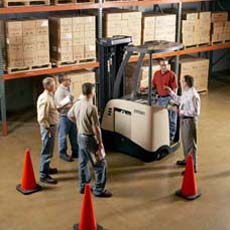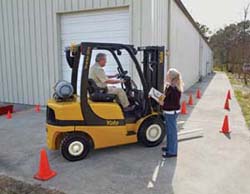Powered Industrial Trucks (Forklift) eTool
Powered Industrial Trucks (Forklift) » Training Assistance

Only trained and competent operators shall be permitted to operate a powered industrial truck. All powered industrial truck operators must be trained and certified by their organizations. [29 CFR 1910.178(l)]
What does the OSHA standard require?
The standard requires employers to develop and implement a training program based on the general principles of safe truck operation, the types of vehicle(s) being used in the workplace, the hazards of the workplace created by the use of the vehicle(s), and the general safety requirements of the OSHA standard. Trained operators must know how to do the job properly and do it safely as demonstrated by workplace evaluation. Formal (lecture, video, etc.) and practical (demonstration and practical exercises) training must be provided. Employers must also certify that each operator has received the training and evaluate each operator at least once every three years. Prior to operating the truck in the workplace, the employer must evaluate the operator's performance and determine the operator to be competent to operate a powered industrial truck safely. Refresher training is needed whenever an operator demonstrates a deficiency in the safe operation of the truck. Training shall consist of a combination of formal instruction (e.g., lecture, discussion, interactive computer learning, video tape, written material), practical training (demonstrations performed by the trainer and practical exercises performed by the trainee), and evaluation of the operator's performance in the workplace. [29 CFR 1910.178(l)(2)(ii)]
Training Program Content
Powered industrial truck operators shall receive initial training in the following topics, except in topics which the employer can demonstrate are not applicable to safe operation of the truck in the employer's workplace. [29 CFR 1910.178(l)(3)]
Truck-related Topics [29 CFR 1910.178(l)(3)(i)]
-
Operating instructions, warnings, and precautions for the types of truck the operator will be authorized to operate.
-
Differences between the truck and the automobile.
-
Truck controls and instrumentation: where they are located, what they do, and how they work.
-
Engine or motor operation.
-
Steering and maneuvering.
-
Visibility (including restrictions due to loading).
-
Fork and attachment adaptation, operation, and use limitations.
-
Vehicle capacity.
-
Vehicle stability.
-
Any vehicle inspection and maintenance that the operator will be required to perform.
-
Refueling and/or charging and recharging of batteries.
-
Operating limitations.
Workplace-related Topics [29 CFR 1910.178(l)(3)(ii)]
-
Surface conditions where the vehicle will be operated.
-
Composition of loads to be carried and load stability.
-
Load manipulation, stacking, and unstacking.
-
Pedestrian traffic in areas where the vehicle will be operated.
-
Narrow aisles and other restricted places where the vehicle will be operated.
-
Hazardous (classified) locations where the vehicle will be operated.
-
Ramps and other sloped surfaces that could affect the vehicle's stability.
-
Closed environments and other areas where insufficient ventilation or poor vehicle maintenance could cause a buildup of carbon monoxide or diesel exhaust.
-
Other unique or potentially hazardous environmental conditions in the workplace that could affect safe operation.
If an operator was previously trained in one of these topics, and the training is appropriate to the truck and working conditions encountered, additional training on that topic is not required if the operator has been evaluated and found competent to operate the truck safely.
Trainees may operate a powered industrial truck only:
-
Under the direct supervision of persons who have the knowledge, training, and experience to train operators and evaluate their competence.
-
Where such operation does not endanger the trainee or other employees.
Refresher training and evaluation: [29 CFR 1910.178(l)(4)]
Refresher training, including an evaluation of the effectiveness of that training, shall be conducted to ensure that the operator has the knowledge and skills needed to operate the powered industrial truck safely. Refresher training in relevant topics shall be provided to the operator when:
-
The operator has been observed to operate the vehicle in an unsafe manner.
-
The operator has been involved in an accident or near-miss incident.
-
The operator has received an evaluation that reveals that the operator is not operating the truck safely.
-
The operator is assigned to drive a different type of truck.
-
A condition in the workplace changes in a manner that could affect safe operation of the truck.
Each operator's performance must be evaluated at least once every three years.
Employers must certify that each operator has been trained and evaluated in accordance with the OSHA standard. [29 CFR 1910.178(l)(6)]
The certification must include:
-
Operator name.
-
Training date.
-
Evaluation date.
-
Name of person(s) performing the training or evaluation.

Before developing your operator training program, you should become familiar with the OSHA standard for powered industrial trucks and any operator's manuals for the equipment in your workplace.
-
Identify the types of powered industrial trucks in your workplace and those employees who will be required to operate the vehicles.
-
Identify your training methods.
-
Develop the content for your training program.
-
Provide for employee evaluation.
-
Include refresher training.
It is important to recognize that training, although essential, will not be enough to eliminate accidents. To be most effective, operator training should be part of a larger comprehensive powered industrial truck safety program that includes the following elements:
-
Hazard identification and possible solutions.
-
Training (of both truck operators and those personnel working near lift trucks) and evaluation of operator competence.
-
Supervision (site survey, ongoing hazard assessment).
-
Operating procedures (company policies, recordkeeping, safety practices).
-
Maintenance and repair procedures.
-
Facility design.
-
Lift truck selection criteria (equipment survey of truck types, attachments and modifications).
Additional Information:
- OSHA Instruction CPL 02-01-028 (CPL 2-1.28A) - Compliance Assistance for the Powered Industrial Truck Operator Training Standards (November 30, 2000).
- Training and Reference Materials – Powered Industrial Trucks provides additional operator training resources.
- Powered Industrial Trucks OSHA Safety & Health Topics page includes links to other Safety and Health sites related to powered industrial trucks.

